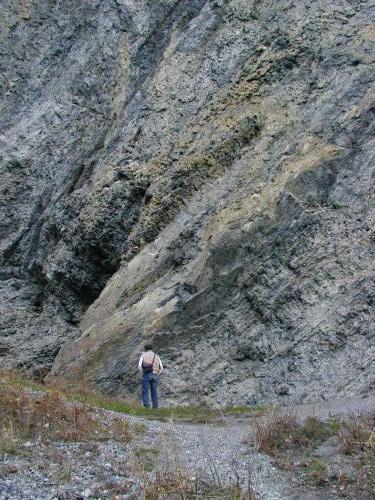
[p1010094.jpg]
From How Old Is That Mountain? A Visitor's Guide to the Geology of Banff and Yoho National Parks, C. J. Yorath:
What you are looking at across the ponds is an ancient reef. The reef is formed from the shells of lime-secreting organisms, such as stromatoporoids, which, some 370 million years ago, built this structure in the warm, shallow waters covering the eastern miogeocline and adjacent platform. It closely resembles the tropical coral reefs of today. This reef, which developed in the Cairn Formation of the Fairholme Group, is identical to much larger structures that act as petroleum reservoirs beneath the Alberta plains. ... If you walk along the path at the base of the large mound you will notice that the rock is full of holes. The holes resulted from the chemical change from calcite to dolomite in the centres of stromatoporoids, shortly after the reef was buried and killed. The reef, like those beneath the plains, was buried over a period of many millions of years. The initial deposits that accumulated beside and over these reefs were black, limy shales containing abundant organic matter derived from decomposed cellular material of marine organisms. With progressively deeper burial the added pressure and heat caused the organic material to change into liquid and gaseous petroleum which later was squeezed out of the limy shales, ultimately becoming trapped in the sponge-like porous reef. In the case of the Grassi Lakes reef, the forces accompanying mountain building elevated this part of the miogeocline; consequently all of the surrounding and younger black shales that once covered the reef have been eroded away. If this reef ever contained oil and gas, they have long since disappeared. From the trail at the base of the cliff you can get a good look at the several parts of the reef because, during uplift of the mountains, it was conveniently turned on its side. At its base, closest to the lake shore, the rocks consist of sediments which accumulated in shallow lagoons. These in turn are overlain by carbonate strata formed from the shells of stromatoporoids and corals that built the reef. You will have no difficulty in recognizing the organic origin of the reef as the strata at some places are composed entirely of fossils.

[p1010094.jpg]
Copyright © Akkana Peck.